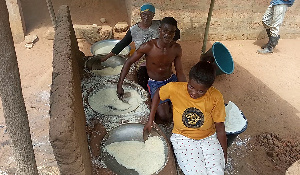Hundreds of the indigenes in Sekesua, a farming community in the Upper Manya Krobo District (UMKD) of the Eastern Region rely on cassava farming and gari processing as a primary source of livelihood.
Mostly done under sheds in the open compounds of homes, the residents are usually up by as early as 6 am to begin the day’s business which usually runs until late evening.
With hardly a home in the community without activity, the mainstay is serving as meaningful employment for residents; men, women and even children.
The community is noted for producing gari of high quality, employing hundreds of the community members either on a full or part-time basis and subsequently selling at the Sekesua market and nearby Asesewa.
The residents say they are forced to plant only cassava and maize and do not have options of cultivating other crops, explaining that the other crops do not do so well on their soil.

The relatively low returns on cassava sales mean income levels are low, forcing them to resort to the processing of their cassava into gari which sells at relatively higher prices compared to the raw cassava.
The intended establishment of a gari, starch and starch spray factory by the Akufo-Addo government in the enclave was aimed at supporting cassava farmers in the enclave and the District as a whole. Six years on, however, this hasn’t seen the light of day.
In the absence of the factory, most cassava farmers manually process the gari at home.
Recently, GhanaWeb visited the area to interact with the processors.
25-year-old Sakitey Evans also engages in the activity with his wife and other members of the family, as their primary and only source of livelihood. Having been in the business over the past ten years, he told GhanaWeb that engaging in the activity as a child growing up encouraged him to fully establish himself in it as an adult for his livelihood.
Currently engaged in the job with his family, Evans asserted: “There are no jobs so this is what we are engaged in. I undertook the gari processing with my father [when growing up] and as an adult, I decided to do it too.”
He however expressed regret at what he said are the poor returns from the activity. According to him, the income accrued from selling the product is insufficient. Evans while describing the activity as tiring and difficult said, “There is not much we make from the sale of the gari. What we earn is inadequate to cater for our upkeep. The market is also not very encouraging.”
Madam Maku Tetteh, a 60-year-old mother of three has also been engaged in the job for the past twenty years with her husband and some of her children. She was engaged in the job with her husband and son at the time GhanaWeb visited her home.
Asked how her business began, she said that as a cassava farmer, the lack of appreciable returns from selling the cassava was her major drive to venture into processing her stuff into the product. “Here, maize and cassava are the only crops that do well when planted, other crops do not do well.”
From planting the cassava, harvesting, peeling and processing into gari, according to madam Maku Tetteh is a tedious job. But she has other challenges she shared with this Correspondent. “You process the gari the whole day, the heat is scorching you, the smoke is also getting into your eyes,” she complained.
She, therefore, pleaded with the government and other benevolent groups to come on board and assist the community and processors with modern equipment to facilitate the job and ease their pain.
24-year-old Ayenor Christopher who has been engaged in the job for the past fifteen years as a child and adult also appealed for equipment to help them in their job.
“Have you seen how we’re suffering? We need machines, we need the machines to process the gari for us. We need good things to come to our town because we’re suffering,” said the young man showing his blistered fingers to this Correspondent.
The building of the factory, among others, was to address the lack of marketing opportunities for cassava farmers in the Upper Manya Krobo District (UMKD). Per this, farmers were expected to be encouraged to produce to feed the factory with their produce which was to be processed into gari and other products on a commercial scale.
This would also provide a ready market for cassava farmers in the agrarian district where most farmers produce cassava but the lack of a ready market and low returns continue to haunt them.
Watch video below
 People in the process of making gari
People in the process of making gari
